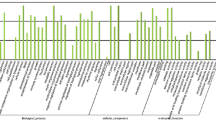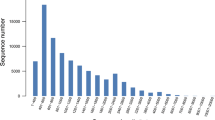Abstract
The transcriptome-based gene set expression of a unique sugarcane stalk infecting fungal pathogen reveals novels insights in deciphering the class of pathogenicity genes present in Colletotrichum falcatum. This study gains significance in understanding the genetic signature of this pathogen using RNA-Seq technology. A total of 53,410,513 reads (24,732 transcripts) specific to C. falcatum were generated, and 13,320 genes were predicted. Gene ontology distributions have been grouped into three domains as biological (3053), cellular (1601) and molecular functions (3444). KEGG annotations represented pathway biomolecules such as carbohydrates, lipids, nucleotides, amino acids, glycans, cofactors, vitamins, terpenoids and polyketides. The genes for virulence have been classified and grouped into candidate effectors, transition-specific and secondary metabolites, proteases, transporters and peptidases which revealed that C. falcatum transcripts encode a large number of secondary metabolites and membrane transporters. Gene enrichment analysis revealed that the number of transporters encoded by C. falcatum is significantly more as compared to that encoded by several other Colletotrichum spp. Phylogenomics analysis indicated that C. falcatum is closely related to C. graminicola and C. sublineola infecting related host plants, maize and sorghum, respectively. This study provides a comprehensive understanding of C. falcatum pathobiology and has identified many candidate genes/putative functions possibly required for its pathogenesis .






Similar content being viewed by others
References
Baroncelli, R., J.M. Sanz-martín, G.E. Rech, S.A. Sukno, and M. Thon. 2014. Draft genome sequence of Colletotrichum sublineola a destructive pathogen of cultivated sorghum. Genome Announcement 2 (3): 10–11.
Cannon, P.F., U. Damm, P.R. Johnston, and B.S. Weir. 2012. Colletotrichum—Current status and future directions. Studies in Mycology 73: 181–213.
Cantarel, B.L., P.M. Coutinho, C. Rancurel, T. Bernard, V. Lombard, and B. Henrissat. 2009. The Carbohydrate-Active EnZymes database (CAZy): an expert resource for glycogenomics. Nucleic Acids Research 37: D233–D238.
Casado-Díaz, A., S. Encinas-Villarejo, B.D.L. Santos, E. Schilirò, E.M. Yubero Serrano, F. Amil Ruíz, and J.L. Caballero. 2006. Analysis of strawberry genes differentially expressed in response to Colletotrichum infection. Physiologia Plantarum 128: 633–650.
Damm, U., R. Barroncelli, L. Cai, Y. Kubo, R.J. O’Connell, B. Weir, K. Yoshino, and P.F. Cannon. 2010. Colletotrichum: Species, ecology and interactions. IMA Fungus 1 (2): 161–165.
Gan, P., K. Ikeda, H. Irieda, M. Narusaka, R.J. O’Connell, Y. Narusaka, and K. Shirasu. 2013. Comparative genomic and transcriptomic analyses reveal the hemibiotrophic stage shift of Colletotrichum fungi. New Phytologist 197: 1236–1249.
Houterman, P.M., B.J. Cornelissen, and M. Rep. 2008. Suppression of plant resistance gene-based immunity by a fungal effector. PLoS Pathogens 4: e1000061.
Jupe, J., R. Stam, A.J. Howden, J.A. Morris, R. Zhang, P.E. Hedley, and E. Huitema. 2013. Phytophthora capsici-tomato interaction features dramatic shifts in gene expression associated with a hemi-biotrophic lifestyle. Genome Biology 14: R63.
Kanehisa, M., and S. Goto. 2000. KEGG: Kyoto encyclopedia of genes and genomes. Nucleic Acids Research 28: 27–30.
Kanehisa, M., S. Goto, Y. Sato, M. Furumichi, and M. Tanabe. 2012. KEGG for integration and interpretation of large-scale molecular datasets. Nucleic Acids Research 40: D109–D114.
Kleemann, J., L.J. Rincon-Rivera, H. Takahara, U. Neumann, E.V.L. van Themaat, and R.J. O’Connell. 2012. Sequential delivery of host-induced virulence effectors by appressoria and intracellular hyphae of the phytopathogen Colletotrichum higginsianum. PLoS Pathogens 8 (4): e1002643.
Krogh, A., B. Larsson, G. von Heijne, and E.L. Sonnhammer. 2001. Predicting transmembrane protein topology with a hidden Markov model: Application to complete genomes. Journal of Molecular Biology 305: 567–580.
Lister, R., B.D. Gregory, and J.R. Ecker. 2009. Next is now: New technologies for sequencing of genomes, transcriptomes, and beyond. Current Opinion in Plant Biology 12 (2): 107–118.
Malathi, P., R. Viswanathan, and R. Jothi. 2006. Specific adaptation of Colletotrichum falcatum pathotypes to sugarcane cultivars. Sugar Tech 8: 52–56.
Malathi, P., R. Viswanathan, A. Ramesh Sundar, N. Prakasam, P. Padmanaban, R. Jothi, S.R. Renuka Devi, and M. Poongothai. 2010. Variability among Colletotrichum falcatum pathotypes used for screening red rot resistance in sugarcane. Sugar Cane International 28 (2): 47–52.
Mardis, E.R. 2013. Next-generation sequencing platforms. Annual Reviews of Analytical Chemistry 6 (1): 287–303.
McDowell, J.M. 2013. Genomic and transcriptomic insights into lifestyle transitions of a hemi-biotrophic fungal pathogen. New Phytologist 197: 1032–1034.
Meinhardt, L.W., G. Gilson, L. Costa, D.P.T. Thomazella, P. José, P.L. Teixeira, and B.A. Bailey. 2014. Genome and secretome analysis of the hemibiotrophic fungal pathogen Moniliophthora roreri, which causes frosty pod rot disease of cacao: Mechanisms of the biotrophic and necrotrophic phases. BMC Genomics 15: 164. doi:10.1186/1471-2164-15-164.
Moriya, Y., M. Itoh, S. Okuda, A.C. Yoshizawa, and M. Kanehisa. 2007. KAAS: An automatic genome annotation and pathway reconstruction server. Nucleic Acids Research 35 (Suppl 2): 182–185.
Morozova, O., and M. Marra. 2008. Applications of next-generation sequencing technologies in functional genomics. Genomics 92: 255–264.
Münch, S., U. Lingner, D.S. Floss, N. Ludwig, N. Sauer, and H.B. Deising. 2008. The hemibiotrophic lifestyle of Colletotrichum species. Journal of Plant Physiology 165: 41–51.
O’Connell, R.J., M.R. Thon, S. Hacquard, S.G. Amyotte, J. Kleemann, M.F. Torres, and L.J. Vaillancourt. 2012. Lifestyle transitions in plant pathogenic Colletotrichum fungi deciphered by genome and transcriptome analyses. Nature Genetics 44: 1055–1060.
Oh, Y., N. Donofrio, H. Pan, S. Coughlan, D. Brown, S. Meng, and R.A. Dean. 2000. Transcriptome analysis reveals new insight into appressorium formation and function in the rice blast fungus Magnaporthe oryzae. Genome Biology. doi:10.1186/gb-2008-9-5-r85.
Park, J., S. Lee, J. Choi, K. Ahn, B. Park, S. Kang, and Y.H. Lee. 2008. Fungal cytochrome P450 database. BMC Genomics 9: 402.
Petersen, T.N., S. Brunak, G. von Heijne, and H. Nielsen. 2011. SignalP 4.0: Discriminating signal peptides from transmembrane regions. Nature Methods 8: 785–786.
Punta, M., P.C. Coggill, R.Y. Eberhardt, J. Mistry, J. Tate, C. Boursnell, N. Pang, K. Forslund, G. Ceric, J. Clement, A. Heger, L. Holm, E.L. Sonnhammer, S.R. Eddy, A. Bateman, and R.D. Finn. 2012. The Pfam protein families database. Nucleic Acids Research 40: D290–D301.
Quevillon, E., V. Silventoinen, S. Pillai, N. Harte, N. Mulder, R. Apweiler, and R. Lopez. 2005. InterProScan: Protein domains identifier. Nucleic Acids Research 33: 6W116–6W120.
Rawlings, N.D., A.J. Barrett, and A. Bateman. 2012. MEROPS: The database of proteolytic enzymes, their substrates and inhibitors. Nucleic Acids Research 40: D343–D350.
Schafer, W. 1994. Molecular mechanisms of fungal pathogenicity to plants. Annual Review of Phytopathology 32: 461–477.
Stephenson, S., C.M. Stephens, D.J. Maclean, and J.M. Manners. 2005. CgDN24: A gene involved in hyphal development in the fungal phytopathogen Colletotrichum gloeosporioides. Microbiological Research 160: 389–397.
Stergiopoulos, I., and P.J. de Wit. 2009. Fungal effector proteins. Annual Review of Phytopathology 47: 233–263.
Suman, A., S. Lal, A.K. Shasany, A. Gaur, and P. Singh. 2005. Molecular assessment of diversity among pathotypes of Colletotrichum falcatum prevalent in sub-tropical Indian sugarcane. World Journal of Microbiology and Biotechnology 21: 1135–1140.
Taniguti, L.M., P.D.C. Schaker, J. Benevenuto, L.P. Peters, G. Carvalho, A. Palhares, and C.B. Monteiro-Vitorello. 2015. Complete genome sequence of Sporisorium scitamineum and biotrophic interaction transcriptome with sugarcane. PLoS ONE 10 (6): e0129318. doi:10.1371/journal.pone.0129318.
Thakur, K., V. Chawla, S. Bhatti, M.K. Swarnkar, J. Kaur, R. Shankar, and G. Jha. 2013. De novo transcriptome sequencing and analysis for Venturia inaequalis, the devastating apple scab pathogen. PLoS ONE. doi:10.1371/journal.pone.0053937.
Viswanathan, R. 2010. Plant disease: Red rot of sugarcane, 306. New Delhi: Anmol Publishers.
Viswanathan, R., and G.P. Rao. 2011. Disease scenario and management of major sugarcane diseases in India. Sugar Tech 13: 336–353.
Viswanathan, R., and R. Samiyappan. 1999. Red rot disease in sugarcane: A major constraint for the Indian sugar industry. Sugar Cane 17: 9–15.
Viswanathan, R., C.N. Prasanth, P. Malathi, and A.R. Sundar. 2016. Draft genome sequence of Colletotrichum falcatum—A prelude on screening of red rot pathogen in sugarcane. Journal of Genomics 4 (10): 1–3. doi:10.7150/jgen.13585.
Wang, Z., M. Gerstein, and M. Snyder. 2009. RNA-Seq: A revolutionary tool for transcriptomics. Nature Reviews Genetics 10 (1): 57–63.
Wilhelm, B.T., and J.R. Landry. 2009. RNA-Seq-quantitative measurement of expression through massively parallel RNA-sequencing. Nature Methods 48: 249–257.
Wu, Q., L. Xu, J. Guo, Y. Su, and Y. Que. 2013. Transcriptome profile analysis of sugarcane responses to Sporisorium scitamineum infection using Solexa sequencing technology. BioMed Research International Article ID 298920.
Zheng, P., Y. Xia, G. Xiao, C. Xiong, X. Hu, S. Zhang, H. Zheng, Y. Huang, Y. Zhou, S. Wang, G.P. Zhao, X. Liu, R.J. St Leger, and C. Wang. 2011. Genome sequence of the insect pathogenic fungus Cordyceps militaris, a valued traditional Chinese medicine. Genome Biology 12(11):R116. doi:10.1186/gb-2011-12-11-r116.
Zhang, Y., K. Zhang, A. Fang, Y. Han, J. Yang, M. Xue, and W. Sun. 2014. Specific adaptation of Ustilaginoidea virens in occupying host florets revealed by comparative and functional genomics. Nature Communications 5: 3849. doi:10.1038/ncomms4849.
Acknowledgements
The authors are grateful to the Director of ICAR-Sugarcane Breeding Institute, Coimbatore, for providing facilities and encouragement.
Funding
This study was partly funded by Outreach Project of ICAR, ALCOCERA.
Author information
Authors and Affiliations
Corresponding author
Ethics declarations
Conflict of interest
The authors declare that they have no conflict of interest.
Ethical Standards
This article does not contain any studies with human participants or animals performed by any of the authors.
Data Access
All data contributing to this transcriptome initiative have been deposited at the NCBI under BioProject PRJNA272832. The accession number of Sequence Read Achieves (SRA) is SRR1765657.
Electronic supplementary material
Below is the link to the electronic supplementary material.
Rights and permissions
About this article
Cite this article
Prasanth, C.N., Viswanathan, R., Krishna, N. et al. Unraveling the Genetic Complexities in Gene Set of Sugarcane Red Rot Pathogen Colletotrichum falcatum Through Transcriptomic Approach. Sugar Tech 19, 604–615 (2017). https://doi.org/10.1007/s12355-017-0529-3
Received:
Accepted:
Published:
Issue Date:
DOI: https://doi.org/10.1007/s12355-017-0529-3




